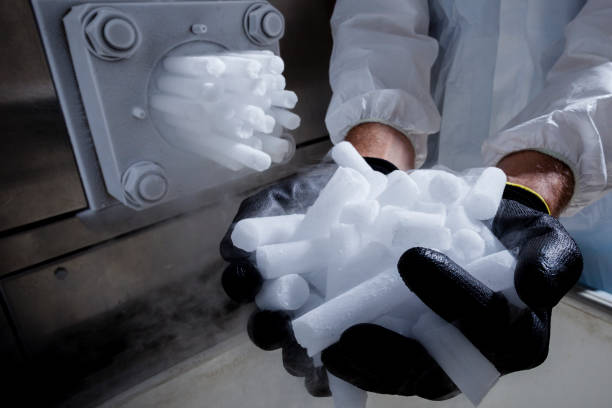
Chemical Formula of Dry Ice: Everything You Need to Know | Dryice.pk
Dry ice, also known as solid carbon dioxide, is a compound with the chemical formula CO2. CO2 is a naturally occurring gas that is produced by a variety of sources, such as volcanic eruptions, forest fires, and human activities like burning fossil fuels.
To create dry ice, CO2 is first pressurized and then cooled to a temperature of -78.5°C (-109.3°F). This causes it to solidify into a white, snow-like substance that can be used in a variety of applications.
Chemical Formula of Dry Ice

1.Dry ice
2.Chemical formula
3.CO2
4.Sublimation
5.Applications
Dry ice has a wide range of applications in various industries, from food to medicine to entertainment. Here are a few examples of how dry ice can be used:
Freeze branding: Dry ice can be used to create permanent markings on livestock, such as cows or horses. By freezing a branding iron with dry ice, the resulting burn will leave a visible scar on the animal’s skin.
Cryotherapy: Dry ice can be used in cryotherapy treatments, which involve exposing the body to extreme cold temperatures for short periods of time. This can have various health benefits, such as reducing inflammation and improving circulation.
Transportation: Dry ice is often used to transport goods that need to be kept at a specific temperature, such as frozen foods, medical supplies, and biological samples. It is also used in the aviation industry to reduce the risk of fire in cargo holds.
Education: Dry ice can be used in classroom demonstrations to teach students about sublimation, gas laws, and other scientific principles.
Properties of Dry Ice

1.Dry ice
2.Chemical formula
3.CO2
4.Sublimation
5.Applications
Dry ice has several unique properties that make it useful in a variety of applications. One of the most notable properties of dry ice is its extreme cold. It has a temperature of -78.5°C (-109.3°F), which is much colder than regular ice made from water. This extreme cold makes it useful in applications where traditional refrigeration methods are not sufficient, such as transporting perishable goods.
Another interesting property of dry ice is its ability to sublimate. When dry ice is exposed to air, it doesn’t melt like regular ice – instead, it changes directly from a solid to a gas. This process can be used to create smoke and fog effects in entertainment applications, as well as to clean machinery and equipment without leaving any residue.
Dry ice is also non-toxic and non-flammable, which makes it a safe choice for a variety of applications. However, it can be dangerous if not handled properly. Dry ice should always be stored and transported in well-ventilated areas to avoid buildup of CO2 gas, and should never be ingested or touched with bare skin.
Applications of Dry Ice
Dry ice has a wide range of applications in various industries, from food to medicine to entertainment. Here are a few more examples of how dry ice can be used:
Freeze branding: Dry ice can be used to create permanent markings on livestock, such as cows or horses. By freezing a branding iron with dry ice, the resulting burn will leave a visible scar on the animal’s skin.
Cryotherapy: Dry ice can be used in cryotherapy treatments, which involve exposing the body to extreme cold temperatures for short periods of time. This can have various health benefits, such as reducing inflammation and improving circulation.
Transportation: Dry ice is often used to transport goods that need to be kept at a specific temperature, such as frozen foods, medical supplies, and biological samples. It is also used in the aviation industry to reduce the risk of fire in cargo holds.
Education: Dry ice can be used in classroom demonstrations to teach students about sublimation, gas laws, and other scientific principles.
Conclusion
n conclusion, the chemical formula of dry ice may be simple, but this substance has a variety of interesting properties and applications. Whether you’re using it to preserve food, create fog effects, or clean machinery, it’s important to handle dry ice with care and follow all safety guidelines. With its unique properties and versatility, dry ice is sure to continue playing an important role in various industries for years to come.
In conclusion, the chemical formula of dry ice may be simple, but this substance has a variety of interesting properties and applications. With its unique properties and versatility, dry ice is sure to continue playing an important role in various industries for years to come. However, it’s important to handle dry ice with care and follow all safety guidelines to avoid any accidents or mishaps.


